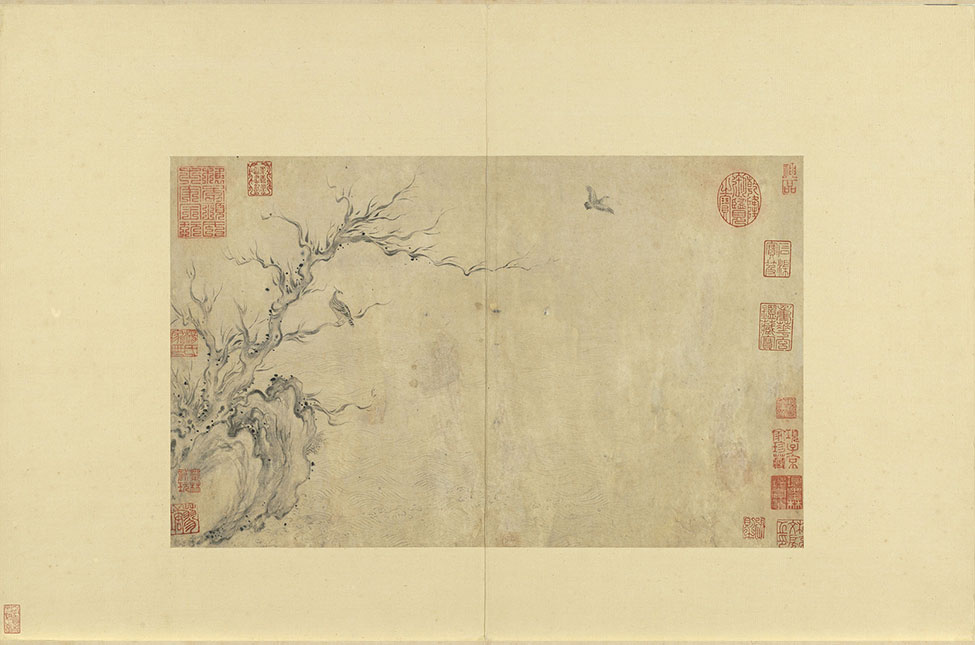Selections
-
Old Tree and Flowing Stream
- Ma Hezhi (fl. 12th c.), Song dynasty
Ma Hezhi’s “Old Tree and Flowing Stream” is the fifth leaf in the album Famous Paintings Through the Ages. It depicts an old tree by a stream with two falcons, one perched in the tree and the other flying off into the void. The composition is succinct with the scenery concentrated on the left side, the branches extending diagonally towards the right and into the sky behind the falcon in flight. Ma Hezhi used nimble, spirited brushwork for the tree that later became known as “leech strokes.”
Since the painting does not include a title label, scholars have debated whether the subject is based on The Classic of Poetry. Some propose that the work indeed is an illustration for The Classic of Poetry, while others believe the lack of any poetry text or preface differs from the conventional format of “illustration right, text left” for text-image versions of The Classic of Poetry surviving today and thus see it as just a general landscape painting.
With its lyrical and sketchy rendering of the scenery, this painting expresses the aesthetic intent associated with the literati, the use of brush and ink exceptionally fine with an archaic air. It has been identified by many scholars as one of the few surviving works from the hand of Ma Hezhi, and for this reason was classified by the government as a National Treasure in 2011.
Introduction to the Artist
The artist’s signature, “Ma Hezhi,” appears in the lower left corner of the painting. According to research by scholars, artists in the Song dynasty generally signed their name with the surname slightly larger than the given name. Though the three characters for “Ma Hezhi” here appear more or less equal in size, the fact that they were written in small characters in an inconspicuous part of the painting with a space between the surname and given name indicates that the signature still corresponds to conventions of the Song dynasty.
Very limited information from the Song dynasty is available in historical materials about Ma Hezhi. Ancient Matters of Wulin ranks him as head of the “court painters,” while Treasured Mirror of Painting from the Yuan dynasty lists Ma as active under the Southern Song emperors Gaozong (r. 1127-1162) and Xiaozong (r. 1162-1189), having the status of “scholar-gentry” and reaching the position of Vice Director for the Ministry of Works in officialdom. Ma Hezhi was known for his superb handling of the brush engaging the work of the painting academy through his status as a “scholar-gentleman.” Few men in the Song dynasty were able to attain such an achievement.
The Brush Method and Style
The brush strokes used to delineate the tree in this painting are short and clearly undulated. The technique of slightly pressing and relaxing the pressure in doing the strokes is similar to writing with a brush that creates curving ink lines varying in thickness. The robust lines in the middle and thinning at the beginning and end are similar in appearance to leeches, which is why in the Ming dynasty they were called “leech strokes.” By varying the thickness, darkness, moisture, and curvature of the strokes, the artist was able to create a rhythmic dynamism similar to the writhing movement of crawling leeches, thereby making the tree appear as if moving up and outwards. Using this kind of energetic line to render a stationary object is no easy task, but Ma Hezhi was able to fully grasp this technique and capture a perfect balance between the object forms and an engaging quality of the brush and ink.
An Impeccable Collection History
The painting has a number of impressed seals indicating that, before entering the Qing imperial collection, it had passed through the hands of several collectors from the thirteenth up to the seventeenth centuries. After entering the imperial household, it was entered into the official catalogue of the collection.
Southern Song Illustrations of The Classic of Poetry
The Classic of Poetry is the earliest compilation of poetry in China and includes 305 works from the early Western Zhou dynasty to the middle Spring and Autumn period (roughly the 11th to 6th centuries BCE). In light of the wide range of knowledge it comprises, and the difficulty in deciphering certain terms and phrases, “illustrated explanations” became a way for later audiences to grasp the meaning of its poetry. Therefore, illustrations of this classic were made in long handscrolls with transcriptions and/or prefaces in regular script using the “illustration right, text left” format.
When Ma Hezhi received imperial orders to do a series of illustrations for The Classic of Poetry, it was a continuation of the tradition for “illustrated explanations for the study of poetry.” However, the particular historical circumstances behind this kind of “imperial patronage” that began in the early Southern Song period were in response to the humiliating loss of the north and the problem of dynastic instability, thereby promoting traditional virtues in the face of political and social turmoil. Since the standards of virtues were considered to lie within the classics of Confucian learning, the early Southern Song rulers advocated the veneration of Confucian education as cultural policy. And among the Confucian classics, the narrative and visual appeal of The Classic of Poetry made it easier to illustrate, so versions of this classic in painting became a means for such propagation of Confucian learning.
Illustration or a Landscape? A Look at the Composition
Other paintings in collections around the world feature compositions similar to the one here. Such a correspondence suggests the existence of an original or the making of multiple copies. The fact that only certain parts of The Classic of Poetry appear to have been chosen for illustration likewise brings up the possibility that “Old Tree and Flowing Stream” served as a source of compositional motifs. The prospect that a formula may have been used in this process of making paintings is a point worthy of further research.
Exhibit List
| Title | Artist | Period |
|---|---|---|
| Old Tree and Flowing Stream | Ma Hezhi (fl. 12th c.) | Song dynasty |

















